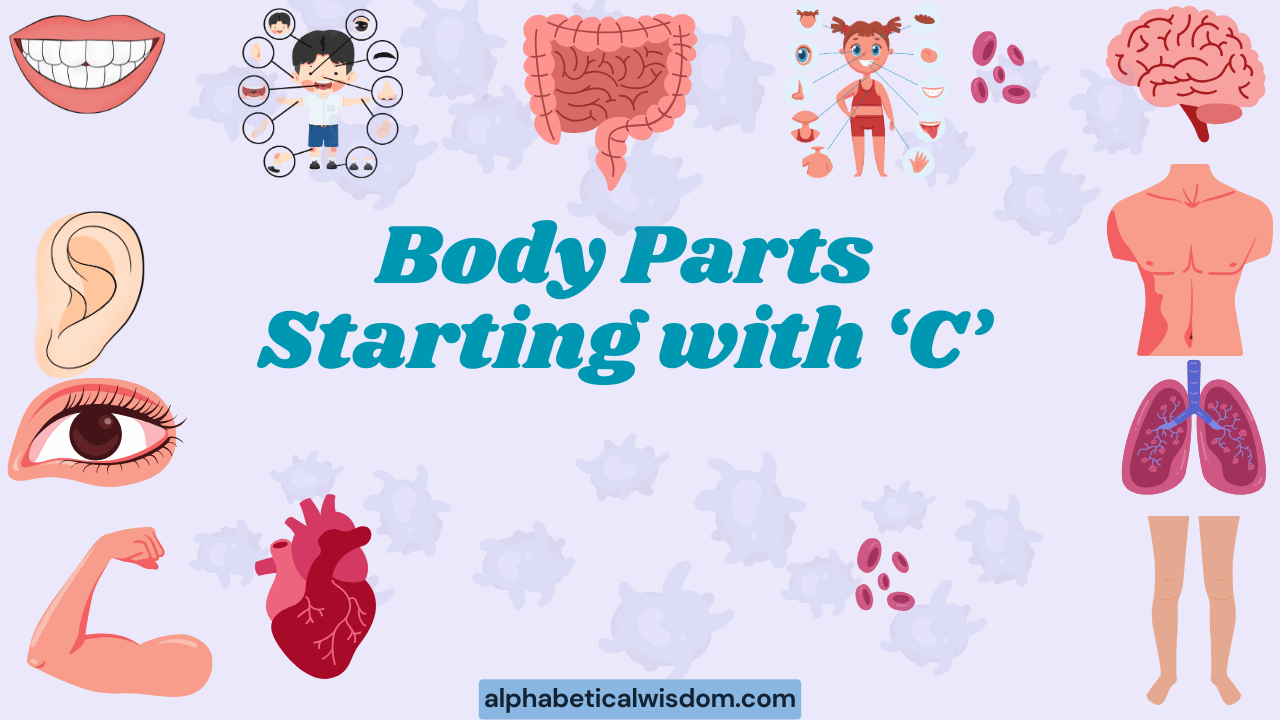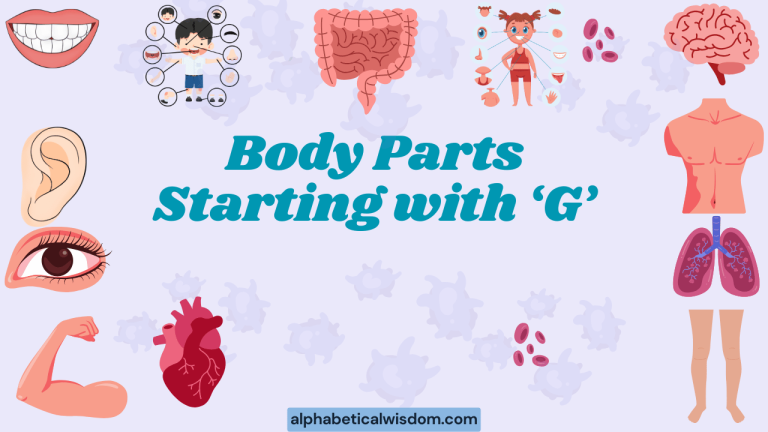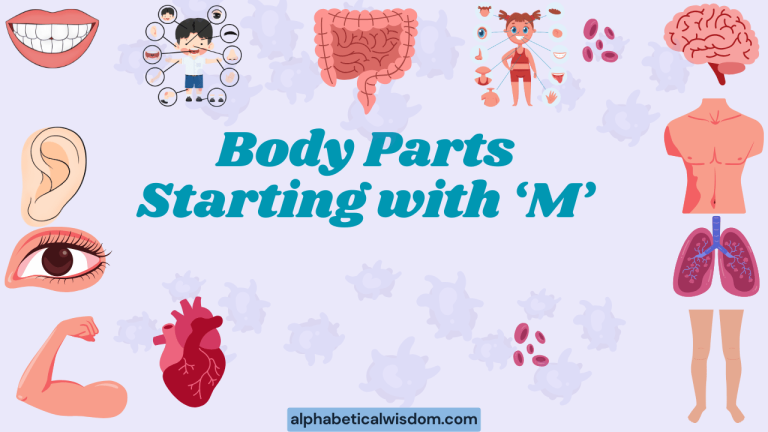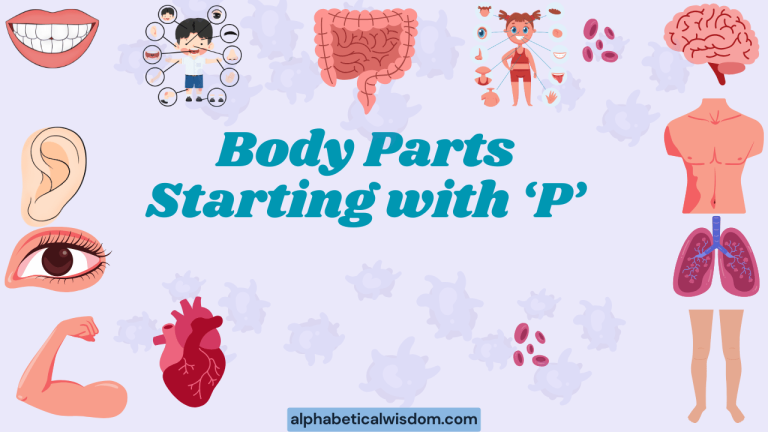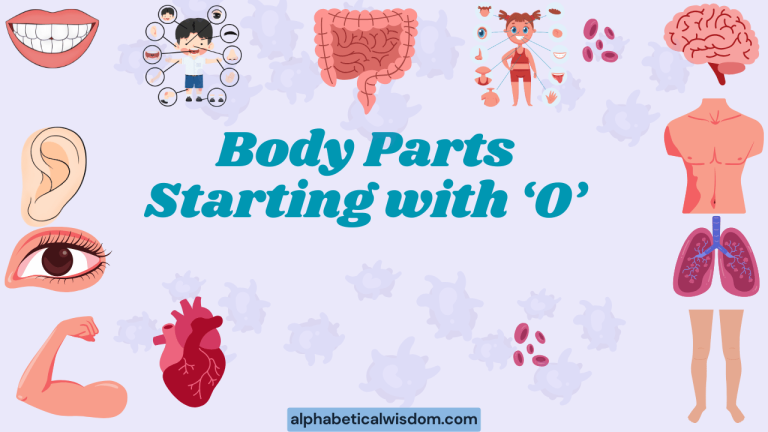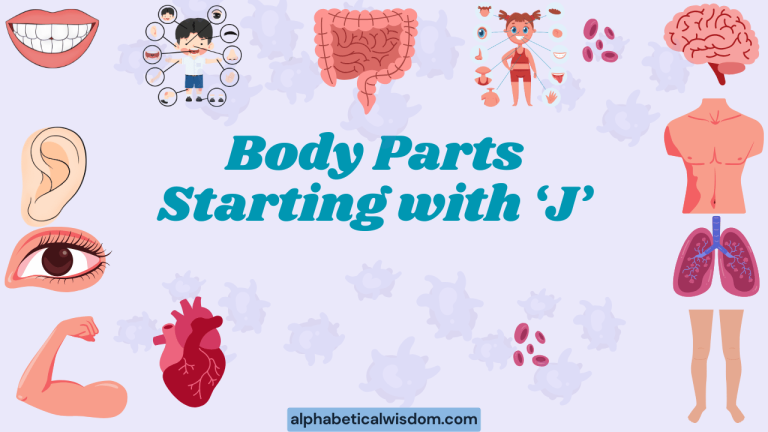Body Parts Starting With ‘C’: A Grammatical Exploration
Understanding the vocabulary of body parts is fundamental to English proficiency. This article focuses on body parts that begin with the letter “c,” providing a comprehensive grammatical exploration.
It covers definitions, usage, common errors, and practice exercises. This guide is beneficial for ESL learners, students preparing for English exams, and anyone looking to expand their knowledge of English vocabulary and grammar related to human anatomy.
Mastering these terms will enhance your ability to describe physical attributes, discuss health-related topics, and improve overall communication skills in English. We delve into the nuances of using these words correctly in various contexts, ensuring a solid grasp of their grammatical roles and proper application.
Table of Contents
- Introduction
- Definitions of Body Parts Starting With ‘C’
- Structural Breakdown and Grammatical Roles
- Types and Categories
- Examples in Sentences
- Usage Rules
- Common Mistakes
- Practice Exercises
- Advanced Topics
- FAQ
- Conclusion
Definitions of Body Parts Starting With ‘C’
This section defines the key body parts starting with the letter ‘c’, providing a clear understanding of each term and its anatomical significance. We will explore the specific meanings and functions of each body part to ensure a comprehensive grasp of their importance.
Key Terms
- Calf: The muscular back part of the lower leg, between the knee and the ankle. It is primarily composed of the gastrocnemius and soleus muscles.
- Canthus: The corner of the eye where the upper and lower eyelids meet. There are two canthi in each eye, the medial and the lateral canthus.
- Capillaries: The smallest blood vessels in the body that connect arterioles and venules. They facilitate the exchange of oxygen, nutrients, and waste products between the blood and tissues.
- Carotid Artery: A major artery in the neck that supplies blood to the brain, face, and scalp. There are two carotid arteries, the common carotid artery, which bifurcates into the internal and external carotid arteries.
- Cartilage: A flexible connective tissue found in various parts of the body, including the joints, ears, and nose. It provides support and cushioning.
- Cecum: The pouch-like beginning of the large intestine that receives undigested material from the small intestine.
- Cheek: The fleshy part of the face below the eye and between the nose and ear.
- Chest: The upper part of the front of the body, enclosed by the ribs. It contains the heart, lungs, and other vital organs.
- Chin: The protruding part of the face below the mouth.
- Clavicle: Also known as the collarbone, a bone that connects the sternum (breastbone) to the scapula (shoulder blade).
- Coccyx: The tailbone, a small triangular bone at the base of the spine.
- Colon: Also known as the large intestine, the section of the digestive system responsible for absorbing water and electrolytes from undigested food.
- Cornea: The transparent front part of the eye that covers the iris and pupil. It helps to focus light onto the retina.
- Cranium: The skull, the bony structure that protects the brain.
Structural Breakdown and Grammatical Roles
Understanding the grammatical roles of these body parts is crucial for constructing accurate and meaningful sentences. Each term functions as a noun, often serving as the subject or object of a sentence.
This section will break down how these nouns interact with verbs, adjectives, and other parts of speech.
Noun Functions
All the body parts listed above primarily function as nouns. Nouns can be subjects, objects, or complements within a sentence. They can also be modified by adjectives to provide more specific details. Let’s explore how these nouns are used in various grammatical contexts.
Examples of Grammatical Roles
- Subject: The calf muscle was sore after the run.
- Object: He injured his clavicle in the accident.
- Complement: The swelling was near her chin.
- Adjective Modifier: The carotid artery damage required immediate surgery.
Types and Categories
Body parts can be categorized based on their function, location, or type of tissue. Understanding these categories helps to organize your knowledge and use the terms more effectively.
This section will explore these different classifications.
Categorization by Function
- Appendages: Calf (muscle related to movement)
- Skeletal: Clavicle, Coccyx, Cranium
- Vascular: Capillaries, Carotid Artery
- Digestive: Cecum, Colon
- Sensory: Canthus, Cornea
- Facial: Cheek, Chin
- Torso: Chest
- Connective Tissue: Cartilage
Categorization by Location
Body parts can also be grouped by their general location on the body.
- Head: Canthus, Cheek, Chin, Cornea, Cranium
- Neck: Carotid Artery
- Torso: Chest, Colon, Cecum
- Upper Limb: Clavicle
- Lower Limb: Calf
- Spine: Coccyx
Examples in Sentences
This section provides extensive examples of how these body parts are used in sentences. The examples are categorized to illustrate different contexts and usages.
General Usage Examples
The following table provides a variety of sentences using body parts starting with ‘c’. It demonstrates how these terms are incorporated into everyday language.
| Sentence | Body Part |
|---|---|
| The athlete strained his calf during the marathon. | Calf |
| She dabbed at the corner of her eye, near her canthus. | Canthus |
| Capillaries are essential for nutrient exchange in the body. | Capillaries |
| The doctor checked the pulse in the carotid artery. | Carotid Artery |
| Cartilage in the knee provides cushioning and support. | Cartilage |
| The cecum is the beginning of the large intestine. | Cecum |
| He had a birthmark on his left cheek. | Cheek |
| He felt a sharp pain in his chest. | Chest |
| She rested her chin on her hand. | Chin |
| The clavicle connects the shoulder to the sternum. | Clavicle |
| He fell and injured his coccyx. | Coccyx |
| The colon absorbs water from undigested food. | Colon |
| The cornea helps to focus light onto the retina. | Cornea |
| The cranium protects the brain from injury. | Cranium |
| Regular exercise can strengthen your calf muscles. | Calf |
| The ophthalmologist examined the canthus of her eye. | Canthus |
| Tiny capillaries supply blood to every cell in the body. | Capillaries |
| Blockage of the carotid artery can lead to stroke. | Carotid Artery |
| Damaged cartilage can cause joint pain. | Cartilage |
| The cecum’s role in digestion is crucial. | Cecum |
| A smile brightened her cheek. | Cheek |
| He clutched his chest in pain. | Chest |
| He stroked his chin thoughtfully. | Chin |
| A broken clavicle can be very painful. | Clavicle |
| Sitting for long periods can put pressure on the coccyx. | Coccyx |
| The health of the colon is important for overall well-being. | Colon |
| A scratched cornea can be very uncomfortable. | Cornea |
| The human cranium is a marvel of evolutionary engineering. | Cranium |
Medical Context Examples
The following table provides examples of how these body parts are used in a medical context. This is important for understanding medical terminology and healthcare-related discussions.
| Sentence | Body Part |
|---|---|
| The doctor palpated the patient’s calf to check for swelling. | Calf |
| Inflammation of the canthus can indicate an eye infection. | Canthus |
| The skin rash was due to dilated capillaries. | Capillaries |
| A stenosis in the carotid artery was detected during the scan. | Carotid Artery |
| Arthritis can cause the cartilage in the joints to deteriorate. | Cartilage |
| A blockage in the cecum can lead to severe abdominal pain. | Cecum |
| The patient reported pain in the cheek after dental surgery. | Cheek |
| The X-ray revealed a mass in the patient’s chest. | Chest |
| The doctor examined the patient’s chin for signs of swelling. | Chin |
| The clavicle fracture required surgical intervention. | Clavicle |
| Pain in the coccyx is often associated with prolonged sitting. | Coccyx |
| A colonoscopy is performed to examine the colon for abnormalities. | Colon |
| The ophthalmologist examined the cornea for signs of damage. | Cornea |
| The CT scan showed a fracture in the cranium. | Cranium |
| The physical therapist massaged his tight calf muscle. | Calf |
| The patient complained of itching near the inner canthus. | Canthus |
| The physician noted the fragility of the capillaries in the elderly patient’s skin. | Capillaries |
| The surgeon performed an endarterectomy to clear the blocked carotid artery. | Carotid Artery |
| The orthopedist recommended injections to regenerate the damaged knee cartilage. | Cartilage |
| Appendicitis can result if the cecum becomes infected. | Cecum |
| The swelling in her cheek was a result of the tooth extraction. | Cheek |
| The cardiologist ordered an EKG to evaluate the pain in his chest. | Chest |
| The dermatologist examined the lesion on his chin. | Chin |
| The clavicle was stabilized with a plate and screws. | Clavicle |
| The pain in her coccyx worsened after a fall. | Coccyx |
| A high-fiber diet is important for maintaining a healthy colon. | Colon |
| The ophthalmologist prescribed eye drops for the scratched cornea. | Cornea |
| Traumatic brain injury can result from blows to the cranium. | Cranium |
Figurative Language Examples
Body parts are often used in figurative language to create vivid imagery or convey abstract ideas. Here are some examples:
| Sentence | Body Part |
|---|---|
| He was as stubborn as a mule, digging his heels in. | Calf (implied, through action of ‘heels’) |
| She cried until her eyes were red and swollen at the canthus. | Canthus |
| The news spread like wildfire through the veins of the city. | Capillaries(implied through ‘veins’) |
| The project was the heart of their mission. | Carotid Artery (implied, as a vital part) |
| The agreement was the backbone of their partnership. | Cartilage (implied, as a supporting structure) |
| The city was the belly of the beast, full of corruption and greed. | Cecum (implied, as a beginning of something) |
| He turned the other cheek and forgave her. | Cheek |
| He took the problem to heart and worked tirelessly to solve it. | Chest (implied, through ‘heart’) |
| He had a strong jawline that conveyed confidence. | Chin |
| She carried the weight of the world on her shoulders. | Clavicle (implied, as part of the shoulder) |
| He was the backbone of the team, always providing support. | Coccyx (implied as the base of the spine) |
| The legislation was the gut of the new reforms. | Colon (implied, as a vital part) |
| She saw the world through rose-colored glasses. | Cornea (implied, through ‘eyes’) |
| He had a head for numbers. | Cranium |
| The runner’s legs felt like lead after the long race. | Calf (implied through ‘legs’) |
| His words stung like acid in the eye. | Canthus (implied through ‘eye’) |
| The city’s traffic was a maze of veins. | Capillaries (implied through ‘veins’) |
| The truth was the lifeblood of their investigation. | Carotid Artery (implied through ‘lifeblood’) |
| The team was the skeleton of the project. | Cartilage (implied as a supporting structure) |
| The city was the stomach of the nation, consuming resources. | Cecum (implied, as a beginning of something) |
| She blushed, her face turning red. | Cheek |
| He kept the secret close to his heart. | Chest (implied, through ‘heart’) |
| He stood tall, chin up, facing the challenge. | Chin |
| She shrugged her shoulders, indicating indifference. | Clavicle (implied, as part of the shoulder) |
| He sat hunched over, his spine curved with age. | Coccyx (implied as the base of the spine) |
| The government was the guts of the nation, making tough decisions. | Colon (implied, as a vital part) |
| She looked at the world with fresh eyes. | Cornea (implied, through ‘eyes’) |
| He had his head in the clouds. | Cranium |
Usage Rules
Proper usage of these terms requires understanding their specific meanings and contexts. This section outlines the rules governing their use, including common prepositions and idiomatic expressions.
General Rules
- Use the correct anatomical term to describe the specific body part accurately.
- Pay attention to the context to ensure the term is appropriate. For example, use medical terminology in healthcare settings.
- Be aware of idiomatic expressions that use these terms.
Common Prepositions
Certain prepositions are commonly used with these body parts. Here are a few examples:
- In the calf: He felt a cramp in the calf.
- Around the canthus: There was redness around the canthus of her eye.
- Within the capillaries: Oxygen is transported within the capillaries.
- To the carotid artery: Blood flows to the brain through the carotid artery.
- In the cartilage: Damage to the cartilage can cause pain.
- In the cecum: Inflammation occurred in the cecum.
- On the cheek: She had a birthmark on her cheek.
- In the chest: He felt pain in his chest.
- On the chin: He had a beard on his chin.
- Near the clavicle: The pain was located near the clavicle.
- At the coccyx: She felt pain at the coccyx after falling.
- In the colon: Polyps were found in the colon.
- Of the cornea: The health of the cornea is essential for vision.
- Of the cranium: The size of the cranium is related to brain size.
Common Mistakes
Learners often make mistakes when using these terms, particularly confusing similar-sounding words or misusing them in sentences. This section addresses these common errors and provides corrections.
Mistaking ‘Calf’ for ‘Calve’
Calf refers to the body part, while calve is a verb meaning to give birth to a calf (animal). For example:
- Incorrect: The cow will calf soon. He pulled his calve muscle.
- Correct: The cow will calve soon. He pulled his calf muscle.
Incorrect Pluralization
Some learners may incorrectly pluralize these terms. For example:
- Incorrect: He had pains in his chests.
- Correct: He had pains in his chest.
Misusing Medical Terms
Using medical terms incorrectly can lead to misunderstandings. It’s important to understand the specific context in which these terms should be used.
- Incorrect: He hurt his cranium playing soccer.
- Correct: He hurt his head playing soccer. (While ‘cranium’ is technically correct, ‘head’ is more commonly used in general conversation.)
Table of Common Mistakes
Here is a table summarizing common mistakes and their corrections:
| Incorrect | Correct | Explanation |
|---|---|---|
| He hurt his calve. | He hurt his calf. | ‘Calf’ is the body part; ‘calve’ is a verb related to animals. |
| She had pains in her chests. | She had pains in her chest. | ‘Chest’ is usually singular, even when referring to pain in the area. |
| The doctor examined his craniums. | The doctor examined his cranium. | Cranium is singular, referring to the skull. |
| I scratched my corneas. | I scratched my cornea. | Each eye has one cornea. |
| His canthuss was red. | His canthus was red. | Canthus is singular. |
| The capillarys were fragile. | The capillaries were fragile. | Capillaries is plural. |
Practice Exercises
Test your knowledge with these practice exercises. Each exercise focuses on different aspects of using body parts starting with ‘c’.
Exercise 1: Fill in the Blanks
Fill in the blanks with the correct body part starting with ‘c’.
- The doctor checked the pulse in the ________ artery.
- He strained his ________ while running.
- The ________ protects the brain.
- The ________ absorbs water in the digestive system.
- She had a birthmark on her ________.
- The ________ helps focus light in the eye.
- The ________ is the corner of the eye.
- ________ are the smallest blood vessels.
- The ________ bone connects the shoulder to the sternum.
- He rested his ________ on his hand.
Answers: 1. carotid, 2. calf, 3. cranium, 4. colon, 5. cheek, 6. cornea, 7. canthus, 8. capillaries, 9. clavicle, 10. chin
Exercise 2: Correct the Sentence
Correct the following sentences that contain errors related to body parts starting with ‘c’.
- He pulled his calve muscle during the game.
- The doctor examined his chests for any abnormalities.
- She scratched her corneas while rubbing her eyes.
- The canthuss of her eye was red and swollen.
- The capillarys were fragile in the elderly patient.
- The doctor asked him if he felt any pain in his coccyxs.
- The seccum is the beginning of the large intestine.
- The clavicle connects the legs to the torso.
- His cranium was hurting so he took some aspirin.
- I felt a sharp pain in my calfs after the hike.
Answers: 1. He pulled his calf muscle during the game., 2. The doctor examined his chest for any abnormalities., 3. She scratched her cornea while rubbing her eye., 4. The canthus of her eye was red and swollen., 5. The capillaries were fragile in the elderly patient., 6. The doctor asked him if he felt any pain in his coccyx., 7. The cecum is the beginning of the large intestine., 8. The clavicle connects the shoulder to the sternum., 9. His head was hurting so he took some aspirin., 10. I felt a sharp pain in my calves after the hike.
Exercise 3: Multiple Choice
Choose the correct answer for each question.
- Which body part is located in the lower leg?
- a) Clavicle
- b) Calf
- c) Cranium
- Which body part supplies blood to the brain?
- a) Colon
- b) Cornea
- c) Carotid Artery
- Which body part is the beginning of the large intestine?
- a) Cecum
- b) Canthus
- c) Clavicle
- Which body part is also known as the collarbone?
- a) Coccyx
- b) Clavicle
- c) Cornea
- Which body part is the transparent front part of the eye?
- a) Cornea
- b) Canthus
- c) Cheek
- Which body part is the tailbone?
- a) Calf
- b) Coccyx
- c) Craniun
Answers: 1. b, 2. c, 3. a, 4. b, 5. a, 6. b
Advanced Topics
For advanced learners, it’s beneficial to delve into more complex aspects of these body parts, including their etymology, related medical conditions, and variations in different contexts.
Etymology
Understanding the origins of these words can provide deeper insights into their meanings and usage. For example, the word “cranium” comes from the Greek word “kranion,” meaning “skull.”
Medical Conditions
Research common medical conditions associated with these body parts, such as carotid artery stenosis, corneal abrasions, or clavicle fractures. Understanding these conditions will expand your medical vocabulary and comprehension.
Variations in Context
Explore how these terms are used in different fields, such as anatomy, physiology, and sports medicine. Each field may have specific nuances and terminology related to these body parts.
FAQ
Here are some frequently asked questions about body parts starting with ‘c’.
- What is the difference between the calf and the Achilles tendon?
The calf is the muscular part on the back of the lower leg, composed mainly of the gastrocnemius and soleus muscles. The Achilles tendon is a strong tendon that connects the calf muscles to the heel bone. The calf muscles contract to plantarflex the foot, and the Achilles tendon transmits this force to the heel.
- What are the main functions of capillaries?
Capillaries are the smallest blood vessels in the body and are responsible for exchanging oxygen, nutrients, and waste products between the blood and tissues. They connect arterioles and venules, forming a network that allows for efficient delivery of essential substances and removal of metabolic waste.
- Why is the carotid artery important?
The carotid artery is a major artery in the neck that supplies blood to the brain, face, and scalp. It is crucial for delivering oxygen and nutrients to these areas, and any blockage or narrowing of the carotid artery can lead to serious health issues, such as stroke.
- What is the role of cartilage in the body?
Cartilage is a flexible connective tissue that provides support and cushioning in various parts of the body, including joints, ears, and the nose. It helps to reduce friction between bones in joints, allowing for smooth movement, and provides structural support to other tissues.
- What is the function of the cecum?
The cecum is the pouch-like beginning of the large intestine that receives undigested material from the small intestine. It plays a role in absorbing water and electrolytes from the undigested food, and it also harbors bacteria that aid in the fermentation of certain substances.
- What is the purpose of the colonoscopy?
A colonoscopy is a medical procedure used to examine the colon (large intestine) for abnormalities, such as polyps, tumors, or inflammation. It involves inserting a long, flexible tube with a camera attached into the rectum and advancing it through the entire colon, allowing the doctor to visualize the lining and take biopsies if necessary.
- What is the function of the cornea?
The cornea is the transparent front part of the eye that covers the iris and pupil. Its primary function is to help focus light onto the retina, which is essential for clear vision. The cornea also protects the eye from dust, germs, and other harmful substances.
- What is the role of the cranium?
The cranium, also known as the skull, is the bony structure that protects the brain from injury. It consists of several bones that are fused together to form a strong and rigid enclosure around the brain, providing physical protection and support.
- What are the symptoms of a fractured clavicle?
Symptoms of a fractured clavicle (collarbone) typically include pain, swelling, and tenderness in the area of the collarbone. There may also be a visible deformity or bump at the fracture site. It can also be difficult to move the arm on the affected side due to pain.
- What is the cause of pain in the coccyx?
Pain in the coccyx (tailbone), also known as coccydynia, can be caused by various factors, including trauma (such as a fall), prolonged sitting, childbirth, or repetitive strain. In some cases, the cause of coccydynia may be unknown. Poor posture can also contribute to coccyx pain.
Conclusion
Mastering the vocabulary and grammar related to body parts starting with ‘c’ enhances your ability to communicate effectively in English. This article has provided a comprehensive overview of these terms, including their definitions, grammatical roles, usage rules, common mistakes, and practice exercises.
By understanding these concepts, you can improve your fluency, accuracy, and confidence in using English. Continuous practice and exposure to real-world examples will further solidify your knowledge and help you avoid common errors.
Remember to review the examples and exercises regularly to reinforce your learning and expand your vocabulary.
